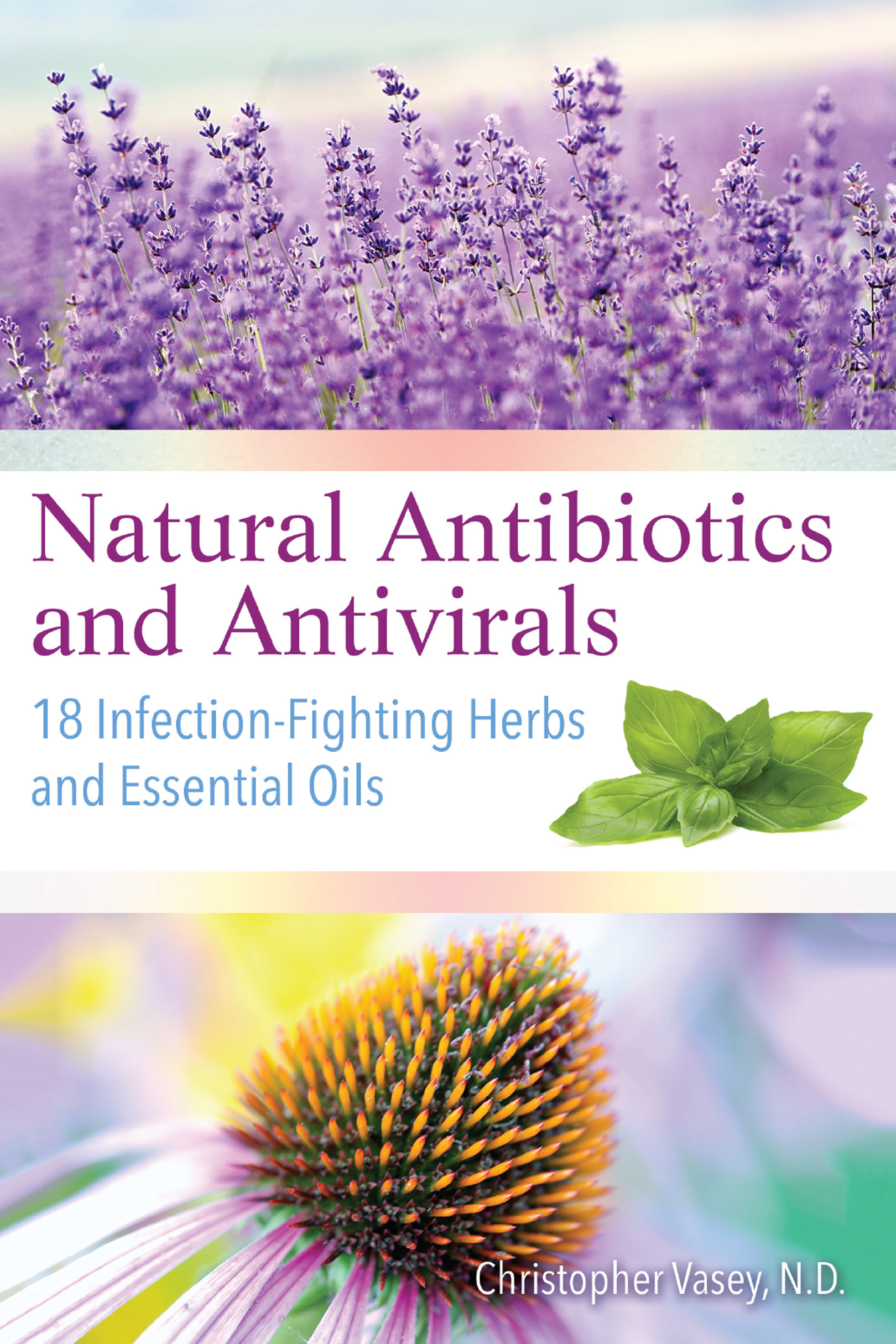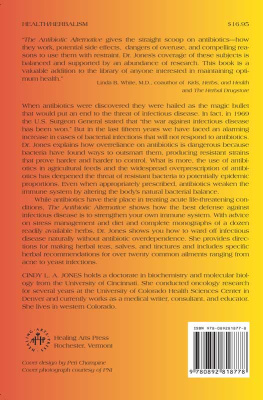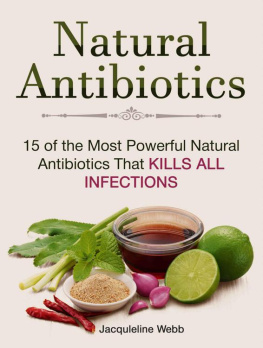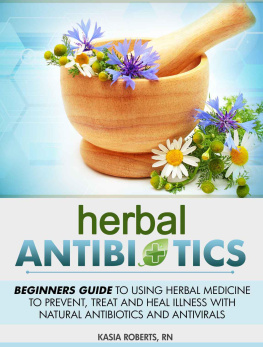

Natural Antibiotics and Antivirals

An informative and invaluable book that explores the application of natural antimicrobial and antiviral plant-based remedies to combat and stave off infection, Natural Antibiotics and Antivirals provides a significant source of reference for the layperson and health care professional alike.
HEATHER DAWN GODFREY, AUTHOR OF ESSENTIAL OILS FOR MINDFULNESS AND MEDITATION
Christopher Vaseys fascinating book explores in detail the powerful world of natural antibiotics (essential oils and herbs) and the role they play in addressing the countless pathological germs we encounter every day. His book is well organized, allowing you to easily reference treatments for common infections, and provides detailed information on creating a symbiotic relationship with our intestinal flora, ultimately leading to radiant health.
CANDICE COVINGTON, AUTHOR OF ESSENTIAL OILS IN SPIRITUAL PRACTICE
Introduction
Nature offers us many natural antibiotics from the plant kingdom that work powerfully against germs while being gentle on the body. The question thus arises: Why are these natural antibiotics no longer known as well as they once were, and why dont we rely on them as we once did?
For much of human history, the true cause of infectious diseases remained a mystery. In the absence of rational treatment, many patients succumbed to their illnesses. It was not until the nineteenth century that evidence for the existence of germs was revealed. The discovery of penicillin in 1929, and then that of many other pharmaceutical antibiotics, finally permitted the specific treatment of infectious diseases. The mortality and suffering connected to these illnesses dropped so spectacularly that the plants we had used empirically until then in the fight against germs were abandoned.
However, over the last few decades, an increasing number of studies have brought these plants back into the spotlight. Extensive research has made it possible to gain a deeper understanding of their antibiotic properties. Not only have they been shown to have a greater therapeutic effectiveness than was once believed, but they have been revealed to have a much greater spectrum of action. Indeed, many of them are also effective against viruses, which is not the case for pharmaceutical antibiotics. In addition, their side effectsif they even have anytend to be benign, and the plants do not prompt germs to develop resistance against them.
Today, we also benefit from better preparation methods for plant-based remedies, which has made it possible to obtain products that are more powerful and more reliable than those of centuries past.
The purpose of this book is to introduce the reader to the world of natural antibiotics by presenting eighteen of the most important ones and explaining how to use them. To do this, I shall first explain the role played by germs in infectious diseases as well as that of the bodys cellular terrain and immune system on the possible development of infections. I will also examine the manner in which standard antibiotics work, as well as the question of their side effects and the development of resistance in germs when they are used, as the use of natural antibiotics provides a solution to both these growing problems.
The fact that modern pharmaceutical antibiotics have side effects and elicit resistance in the bacteria they are meant to treat does not mean that we have to reject them. They provide an enormous service to humankind, and we can only be happy that they exist. In some cases they are indispensable. Rather, the question is how to act with discernment in choosing the most effective remedy for the patient being treated, with effectiveness here meaning the ability to halt the infection without harming the body. As it happens, for mild infections or chronic diseases whose intensity and development are well known to the patient, natural antibiotics are often preferable because of the absence of noxious side effects.
Whatever your personal situation may be, if you have concerns about your health or are dealing with a serious condition, it is essential to seek the informed opinion of a health care professional.
I would like to clarify one vocabulary issue. Throughout this book, I use the term natural antibiotic. Antibiotic is used here in its broad sense. Strictly speaking, that term designates only the substances produced by microorganisms that possess the property of killing pathogenic germs or of inhibiting their growth. But because the molecules of certain plants possess the same properties, and because the term antibiotic has broad public recognition, I will use it in reference to those plants, although plants are hardly microorganisms. I add the adjective natural to the term antibiotics to clearly establish the difference between plant antibiotics and standard pharmaceutical antibiotics.
The History of Natural Antibiotics
Rediscovering the Power of Plant-Based Remedies
Human beings have inhabited the earth for tens of thousands of years, but antibioticsin the form we know them todaywere discovered and perfected a mere hundred years ago. How were our remote ancestors able to muddle through without them? Were methods of fighting infection completely unknown to them?
Since the dawn of time, human beings have turned to plants that possess antibiotic properties. Of course they did not use the term antibiotic, nor did they speak of germs, but they knew that the use of these medicinal plants to treat certain specific illnesses was very effective.
The oldest evidence for the use of plants with antibiotic properties by human beings dates back more than fifty thousand years. Archaeologists have discovered in northern Iraq the skeleton of a man who was buried with a number of different objects, including medicinal plants that are effective against infectionsand that are used by the populace of that region even today.
Studies have also provided evidence that around forty thousand years ago, the aboriginal natives of Australia used numerous plants for healing purposes, particularly the leaves of the tea tree (Melaleuca alternifolia), which has powerful anti-infective properties with a wide spectrum of activity.
Ancient texts reveal that in India more than seven thousand years ago, aromatic waters were used to heal the sick. They were produced from anti-infective plants such as cinnamon, coriander, ginger, and myrrh.
The oldest alembic known to human being was discovered in Pakistan and dates back to around 5000 BCE. Other alembics dating back to 3500 BCE have been found in China. We can assume that in these remote eras, people knew that the active principles of certain plants could be found primarily in their essential oils, and they consequently manufactured objects that would allow them to extract those oils.
Mesopotamian inscriptions dating back almost four thousand years have shown that medicinal plants were used during that time to combat epidemics. The famous epic of Gilgamesh tells how the Chaldeans (3000 BCE) treated themselves almost exclusively with plants. This was also the case at almost the exact same time on the other side of the ocean in America, with the pre-Columbian peoples. For example, the latter used the bark of the cinchona tree (which contains quinine) to fight against fevers in general and those caused by malaria in particular.
Next page






